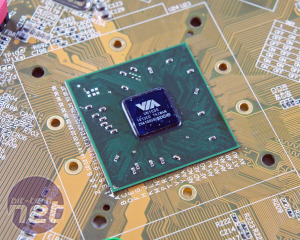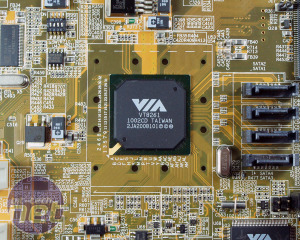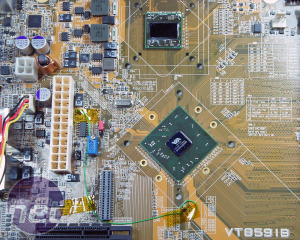VIA Nano Dual-Core Platform
The platform that the new Nano Dual-Core will become part of is a traditional three-chip design of CPU, Northbridge and Southbridge. This method gives VIA the most flexibility to pair the new CPU with any number of its chipsets to appeal to different uses. The Nano Dual-Core is also pin-compatible with current Nano CPUs, so it makes the cost of new designs for VIA customers much lower as well.The downside is that a three-chip system obviously means more PCB space is required, but VIA is not pushing the Nano Dual-Core + VN1000 + VT8261 combo at tiny netbooks. Instead, it intends the market to be basic PCs, ultra-thin notebooks and budget laptops.
The VN1000 Northbridge and VT8261 Southbridge
VIA claims its VN1000 Northbridge is 'the best-performing IGP available'. That's a bold claim, but then again, Nvidia has given up on chipsets altogether and AMD has kept the same basic 16-shader hardware for its integrated graphics since the 780G launched in early 2008. In comparison VIA's VN1000 has a 'Chrome 520' GPU with 32 DirectX 10.1 unified shaders running at 500MHz. There's also OpenCL 1.0 support for GPGPU applications.Whereas the VX855 in the Artigo A1100 could only handle WMV-HD video acceleration in Windows Media Player, the VN1000 sports the ChromotionHD 2.0 hardware that claims to be a 'fully programmable video engine'.
It features video acceleration for MPEG-2, H.264 (up to level 4.1) and Windows Media Video-based codecs including VC-1 (level 3) at full 1080p HD resolutions. Other in-built enhancements include motion compensation, transform, de-blocking, full VLD support, AVS support, per-pixel de-interlacing, gamma correction, de-blocking, sharpening, emboss and neon effects and Non-Linear Anamorphic Scaling (NLAS) of 4:3 content to widescreen resolutions.
VIA has packed the VN1000 with support for HDMI, DVI, DisplayPort, LVDS (a low power, low profile connector for laptop screens) and D-Sub. Any two of the display outputs can be used at once. It may not be Eyefinity, but for integrated graphics having all this included is a bonus.
The Northbridge also includes a dual-channel DDR2/DDR3 memory controller, but the frequency is limited to 800MHz DDR2 or 1,066MHz DDR3. On top there's also connections for an 8x PCI-E slot and four 1x PCI-Express lanes too. This is it for PCI Express as the VT8261 Southbridge handles legacy hardware only, including PCI slots and IDE. Four SATA 3Gbps are included with Native Command Queuing (NCQ), Port Multiplier and Hot Plug support but no RAID support. Curiously, VIA's BIOS has a 'RAID' option but no 'ACHI' for its SATA.
To you and me that may seem old, but it's still a demand of emerging markets.

MSI MPG Velox 100R Chassis Review
October 14 2021 | 15:04













Want to comment? Please log in.